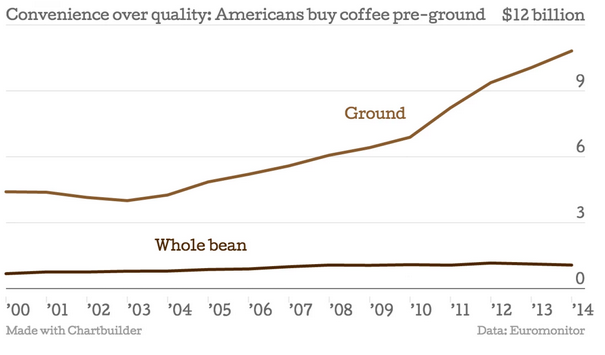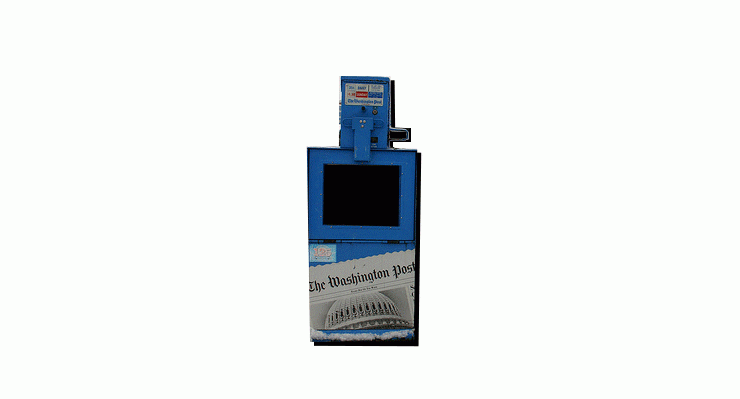Last week the Washington Post released two articles about coffee on the same day, one a little more science-y and one a little more statistics-y. Though they somewhat retread covered ground, they’re both interesting tidbits that are worth a look, or for your convenience, we’ll recap for you.
Clumsy? Order a Latte Instead of Coffee.
Have you ever noticed that a latte or a cappuccino is less likely to spill than a cup of black coffee when being carried around? Physicists have, and they have found out why. Published in Tuesday’s Physics of Fluids, a fluid dynamics journal, the article “Damping of Liquid Sloshing by Foams” written by a team of five physicists explains just how foam on top of beverages helps decrease spillage. And like many great ideas, this one was first concocted thanks to coffee and beer. From Rachel Feldman’s article:
“Emilie Dressaire, who’s now an assistant professor at NYU Polytechnic School of Engineering, started thinking about the integrity of foamy liquids when a Starbucks employee told her she wouldn’t need a lid stopper to keep her latte from spilling. Her colleague Alban Sauret, now a researcher at the French National Center for Scientific Research, had recognized the same difference in foamy beers.
“When carrying pints of Guinness, he’d learned as a student in Europe, sloshing was minimal. In both cases, it seemed the foamy layer on top of the liquid was to thank for the lack of spillage.”
Their experiment was pretty straightforward—fill a glass container with water, dish soap (never a good descriptor when it comes to foam in lattes or cappuccinos), and glycerol (used to make liquids more viscous), and then create a uniform layer of micro-bubbles across the surface of the liquid. The container was then subjected to various rocking motions under a high-speed camera to see how the liquid reacted as more and more foam layers were added to the top.
As it turns out, the foam acted as a buffer, keeping the liquid more stable. A layer only five bubbles deep decreased the liquid’s wave height by 10 times compared to that of a foamless liquid. The physicists believe this is because the foam is helping diffuse the energy of the “splishy-spashy” beverage by creating friction against the glass container.
While these findings have an impact outside of the world of coffee—the researchers say adding a layer of foam can help in the transportation of hazardous liquids, where sloshing needs to be minimized, or, you know, beer—there are too many coffee-related questions that we need answered before we start exploring the application of this research on outside fields. How does this affect micro-foam? Are cappuccinos more stable than lattes? What about Flat Whites!? Which latte art design sloshes less, a heart or a rosetta? These are the questions we need answered, Science. Please make them a priority.
Americans Like to Drink “Bad” Coffee.
Specialty coffee seems like it is everywhere nowadays: Thrive Coffee at Chik-Fil-A, latte art in toothpaste commercials, even Jimmy Kimmel mentioned the United States Barista Championship without a hint of snark or irony. Yet, amid what seems to be a specialty coffee renaissance, the Post’s Roberto A. Ferdman reports that Americans, on average, are drinking “worse” coffee than they have in the past.
Now, defining coffee as “good” or “bad” is a dicey proposition, certainly not something that should be done without serious consideration—so the Post decided to go the simple route and define bad coffee as coffee that has been pre-ground. While evolutions in packaging technologies and barista competitions are starting to question received wisdom on pre-ground coffee to a degree, using pre-ground as a wider market demarcation for quality makes a certain amount of sense. Coffee has a tendency to go stale quickly, and grinding coffee, which increases the total surface area, exponentially increases the rate at which it loses freshness. Even the best Gesha grown at the highest elevation is going to lose its luster if ground far in advance and left to sit on the kitchen counter.

via Washington Post
With their “good” and “bad” coffee definitions chosen, the Post reports that while whole bean sales have remained fairly constant over the past few years, pre-ground coffee sales have sky-rocketed. Here’s their analysis:
“People in this country, on the whole, are actually drinking worse coffee today than they have in the past. And the reason appears to be that they value cheapness over quality—and convenience over everything.”
Bolstering both this claim and the overall uptick in pre-ground sales is the popularity of coffee pods, which have increased sales by 138,324% (!?!OMG?!) over the last 10 years. This ridiculous growth now has Keurig Green Mountain, the coffee used in K-Cups, as the most popular coffee in the country. It owns 20% of the market, which is roughly the same as the second and third most popular brands—Folgers and Starbucks—combined.
The Wa-Po is 100% right that people are drinking a lot of not-so-good coffee, but focusing on the pre-ground distinction here seems a bit superfluous—the story is once again that coffee pods are super bad, mmmkay? Though yes, that is always a worthwhile point to re-iterate, and yes buying whole bean may be an answer.
Most of all, it’s always good to remember that while more and more people are getting into specialty coffee, the fact of the matter is Americans by and large value convenience over quality. Even with new shops opening everyday all across the country, making specialty coffee more accessible to a larger set of the population, its growth is still being greatly outpaced by that of the pre-ground coffee pods.
It’s a good thing everyone loves an underdog.
Zac Cadwalader is a Sprudge.com staff writer based in Dallas. Read more Zac Cadwalader on Sprudge.
Alex Bernson contributed to this reporting.
The post Pods, Foams, And Coffee Tropes In The Washington Post appeared first on Sprudge.


